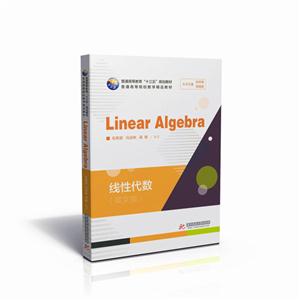線性代數:英文版 版權信息
- ISBN:9787568028288
- 條形碼:9787568028288 ; 978-7-5680-2828-8
- 裝幀:一般膠版紙
- 冊數:暫無
- 重量:暫無
- 所屬分類:>
線性代數:英文版 本書特色
本書采用學生易于接受的知識結構方式和英語表述方式,科學、系統地介紹了線性代數的行列式、矩陣、高斯消元法解線性方程組、向量、方程組解的結構、特征值和特征向量、二次型等知識。強調通用性和適用性,兼顧先進性。本書起點低,難度坡度適中,語言簡潔明了,不僅適用于課堂教學使用,同時也適用于自學自習。全書有關鍵詞索引,習題按小節配置,題量適中,題型全面,書后附有答案。 本書讀者對象為高等院校理工、財經、醫藥、農林等專業大學生和教師,特別適合作為中外合作辦學的國際教育班的學生以及準備出國留學深造學子的參考書。
線性代數:英文版 內容簡介
本書可以作為大學數學線性代數雙語或英語教學教師和準備出國留學深造學子的參考書。特別適合中外合作辦學的國際教育班的學生,能幫助他們較快地適應全英文的學習內容和教學環境,完成與國外大學學習的銜接。本書在定稿之前已在多個學校作為校本教材試用,而且得到了師生的好評。
線性代數:英文版 目錄
Chapter 1 Determinant(1)
1.1
Definition of Determinant(1)
1.1.1 Determinant arising from the solution of linear system(1)
1.1.2 The definition of
determinant of order n(5)
1.1.3 Determine the sign of each term in a determinant (8)
Exercise 1.1(10)
1.2
Basic Properties of Determinant and Its Applications(12)
1.2.1 Basic properties of determinant(12)
1.2.2 Applications of basic properties of determinant(15)
Exercise 1.2(19)
1.3
Expansion of Determinant (21)
1.3.1 Expanding a determinant using one row (column)(21)
1.3.2 Expanding a determinant along k rows (columns)(27)
Exercise 1.3(29)
1.4
Cramer’s Rule(30)
Exercise 1.4(36)
Chapter 2 Matrix(38)
2.1
Matrix Operations(38)
2.1.1 The concept of matrices(38)
2.1.2 Matrix Operations(41)
Exercise 2.1(58)
2.2
Some Special Matrices(60)
Exercise 2.2(64)
2.3
Partitioned Matrices(66)
Exercise 2.3(72)
2.4
The Inverse of Matrix(73)
2.4.1 Finding the inverse of an n×n matrix(73)
2.4.2 Application to economics(81)
2.4.3 Properties of inverse matrix (83)
2.4.4 The adjoint matrix A (or adjA) of A(86)
2.4.5 The inverse of block matrix(89)
Exercise 2.4(91)
2.5
Elementary Operations and Elementary Matrices(94)
2.5.1 Definitions and properties (94)
2.5.2 Application of elementary operations and elementary matrices(100)
Exercise2.5(102)
2.6
Rank of Matrix(103)
2.6.1 Concept of rank of a matrix(104)
2.6.2 Find the rank of matrix(107)
Exercise 2.6(109)
Chapter 3 Solving Linear System by Gaussian
Elimination Method(110)
3.1
Solving Nonhomogeneous Linear System by Gaussian Elimination Method(110)
3.2
Solving Homogeneous Linear Systems by Gaussian Elimination Method(128)
Exercise 3(131)
Chapter 4 Vectors(134)
4.1
Vectors and its Linear Operations(134)
4.1.1 Vectors(134)
4.1.2 Linear operations of vectors(136)
4.1.3 A linear combination of vectors (137)
Exercise 4.1(143)
4.2
Linear Dependence of a Set of Vectors (143)
Exercise 4.2(155)
4.3
Rank of a Set of Vectors(156)
4.3.1 A maximal independent subset of a set of vectors(156)
4.3.2 Rank of a set of vectors(159)
Exercise 4.3(163)
Chapter 5 Structure of Solutions of a System(165)
5.1
Structure of Solutions of a System of Homogeneous Linear Equations (165)
5.1.1 Properties of solutions of a system of homogeneous linear
equations(165)
5.1.2 A system of fundamental solutions (166)
5.1.3 General solution of homogeneous system(171)
5.1.4 Solutions of system of equations with given solutions of the
system(173)
Exercise 5.1(176)
5.2
Structure of Solutions of a System of Nonhomogeneous Linear Equations(178)
5.2.1 Properties of solutions(178)
5.2.2 General solution of nonhomogeneous equations (179)
5.2.3 The simple and convenient method of finding the system of fundamental solutions and particular solution(183)
Exercise 5.2(189)
Chapter 6 Eigenvalues and Eigenvectors of
Matrices(191)
6.1
Find the Eigenvalue and Eigenvector of Matrix(191)
Exercise 6.1(197)
6.2
The Proof of Problems Related with Eigenvalues and Eigenvectors(198)
Exercise 6.2(199)
6.3
Diagonalization(200)
6.3.1 Criterion of diagonalization(200)
6.3.2 Application of diagonalization(209)
Exercise 6.3(210)
6.4
The Properties of Similar Matrices(211)
Exercise 6.4(216)
6.5
Real Symmetric Matrices(218)
6.5.1 Scalar product of two vectors and its basis properties(218)
6.5.2 Orthogonal vector set(220)
6.5.3 Orthogonal matrix and its properties(223)
6.5.4 Properties of real symmetric matrix(225)
Exercise 6.5(229)
Chapter 7 Quadratic Forms (231)
7.1
Quadratic Forms and Their Standard Forms(231)
Exercise 7.1(236)
7.2
Classification of Quadratic Forms and Positive Definite Quadratic(Positive
Definite Matrix)(237)
7.2.1 Classification of Quadratic Form(237)
7.2.2 Criterion of a positive definite matrix(239)
Exercise 7.2(241)
7.3
Criterion of Congruent Matrices(242)
Exercise 7.3(245)
Answers to Exercises(246)
Appendix Index(266)
展開全部
線性代數:英文版 作者簡介
毛綱源,武漢理工大學資深教授,畢業于武漢大學,留校任教,后調入武漢工業大學(現合并為武漢理工大學)擔任數學物理系系主任,在高校從事數學教學與科研工作40余年,除了出版多部專著(早在1998年,世界科技出版公司World Scientific Publishing Company就出版過他主編的線性代數Linear Algebra的英文教材)和發表數十篇專業論文外,還發表10余篇考研數學論文。 主講微積分、線性代數、概率論與數理統計等課程。理論功底深厚,教學經驗豐富,思維獨特。曾多次受邀在各地主講考研數學,得到學員的廣泛認可和一致好評:“知識淵博,講解深入淺出,易于接受”“解題方法靈活,技巧獨特,輔導針對性極強”“對考研數學的出題形式、考試重點難點了如指掌,上他的輔導班受益匪淺”。 馬迎秋,北京師范大學珠海分校副教授,畢業于渤海大學,愛爾蘭都柏林大學數學碩士。主講微積分、線性代數、數學教學論、數學教學設計、數學史與數學文化等課程。在國內外權wei期刊發表中英文論文10余篇。 梁敏,北京師范大學珠海分校副教授,畢業于天津大學,美國托萊多大學數學碩士,美國羅格斯大學統計學碩士。主講微積分、線性代數、概率論與數理統計、商務統計、運籌學等課程。在國內外權wei期刊發表中英文論文10余篇。


















